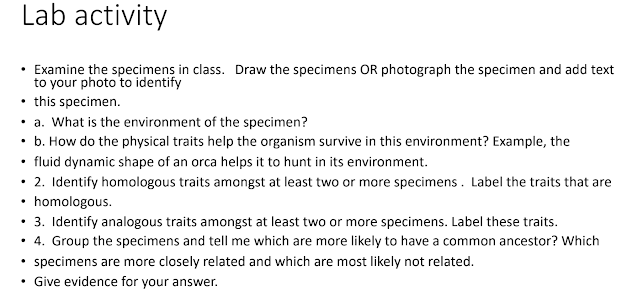We will go over these slides on GEOLOGICAL TIME
And this is some background info on how fossils are formed. please do this worksheet using the link here for finding the answers.
HERE IS A SECOND LINK
This is 10 marks
Geological Time Lab
USE THE DRAWING PAPER AND MAKE COLOUR AND INK DRAWINGS OF SPECIMENS
Station 1 . ROW 1 THREE drawings
Draw TWO samples of SANDSTONE
DRAW ONE SAMPLE OF SHALE
Answer the following questions
1. How is sandstone formed? Explain how a fossil might be formed in Sandstone
2. How is shale formed? Explain how a fossil can form in shale
Station 2. Known Fossils THREE DRAWINGS
A. COMPARATIVE TEACHING COLLECTION ROW 2
Photograph all fossils summarize their descriptions
MAKE ONE DRAWING which includes one fossil and one modern day equivalent. Label the drawings with the descriptions shown
B. FOSSIL BOX and fossil bucket. ROW 3 Identify 7 and MAKE TWO DRAWINGS
1. photograph 7 fossils from this box and identify them.
2. Make two drawings consisting of:
a. a careful drawing of ONE FOSSIL from the box.
b. a drawing of the actual organism that it came from using an internet search.
c. Tell me what era it came from as well as its environmental conditions. for example, if your fossil is a SHARK TOOTH, then the organism it comes from is a SHARK and it's environment is marine. So your drawing in section 2B b is a drawing of a shark in its marine environment.
Station 3. ROW 4 UNKNOWN FOSSILS. 3 DRAWINGS
Choose 3 to draw
CHOOSE 3 fossils to identify. photograph them and give evidence that you can identify the fossil using the known fossils.
EVALUATION. 60 marks total
lab portion total 60 marks
50-60 marks - you photograph all the fossils and you make drawings
3 drawings for station 1
3 drawings for station 2 and
3 drawings for station 3.
You complete all your observations.
30-45 - you completed all the drawings and it is not in colour . Your drawings look great. Or, you have beautiful drawings but did not complete all the drawings for each station.
10-30 - This looks great and you need to complete the work
0-9 - this work is incomplete.














